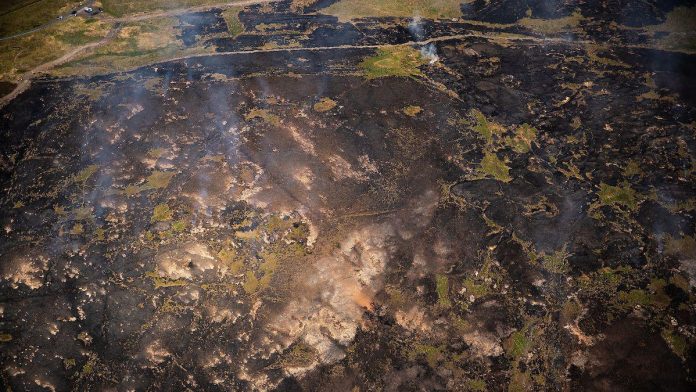A new survey on a fire-ravaged site has shed light on the struggle for natural environments to recover from catastrophic events.
In 2018, a wildfire broke out across the heathlands, peatlands and woodlands at Smithills near Bolton . Such was the extent of the fire, it threatened to engulf nearby properties and caused huge damage to wildlife.
During weeks of burning, where emergency services worked day and night for 41 days to tackle the blaze, a third of the 1,700-acre site was destroyed, including plants and trees. Animals were dispersed, with the moorland resembling a charred landscape.
Now, there are signs the vegetation is recovering and more animals and birds have been spotted. But, as a new survey shows, it is the peatland that is going to take longer to recover – with a complex restoration project under way.
Smithills site manager Oliver Stainthorpe of the Woodland Trust said: “During the fire, all the peat mass was damaged, 20cm was lost and burnt away. There are still no signs of this recovering.
“The grim reality is that it is going to take something like 200 years to regenerate the peat to how it was. It shows the damage catastrophic events – which are more likely due to climate change – can have on nature.
“But it is not all doom and gloom – nature is bouncing back in some ways. There has been much recovery from plants and animals and our survey will help us to shape the future recovery and restoration of the complex environment under the ground.”
The moorland surveys involve painstakingly moving across the vast landscape, surveying 2m by 2m squares in selected areas, and charting the wildlife and flora. Although the surveys are ongoing, so far they have found many different species, including purple moor grass, turfed hair grass, wavy hair grass, mat-grass and sphagnum moss – the ‘sponge of the moorland’ – making its way back. Meanwhile, bird species such as meadow pipits, kestrels and skylarks have also been spotted.
For measuring peat beneath the ground, volunteers use metre-long peat sticks which join together to probe the ground. The purpose of this is not to see change but to work out what restoration would work best.
Another aspect of the survey involves identifying drains using maps and GIS software. Drains were originally constructed in the moorland to provide water during the industrial era, but they continue to exist and have a negative impact on moorland health.
The team is identifying the location and characteristics of the drains. This information will contribute to the moorland restoration plan, which aims to reduce water flow and retain water on the moors.
Mr Stainthorpe added: “Our key aim is the restoration of the site. Smithills is blessed with a mosaic of habitats – peatlands, uplands, oak woodland and upland wet woodland. Improved heathlands will increase local biodiversity, capture carbon, and decrease flood risk.
“As well as restoration, we must try protecting the site from such a devastating incident occurring again. This summer we have had volunteers doing fire patrols to detect any threats.
“Nature can bounce back but the damage caused from such a catastrophic event can take hundreds of years to overcome.”
At 1,700 acres, Smithills Estate is the largest site the Woodland Trust has ever acquired in England, steeped in history and shadowed by the famous Winter Hill TV mast.







